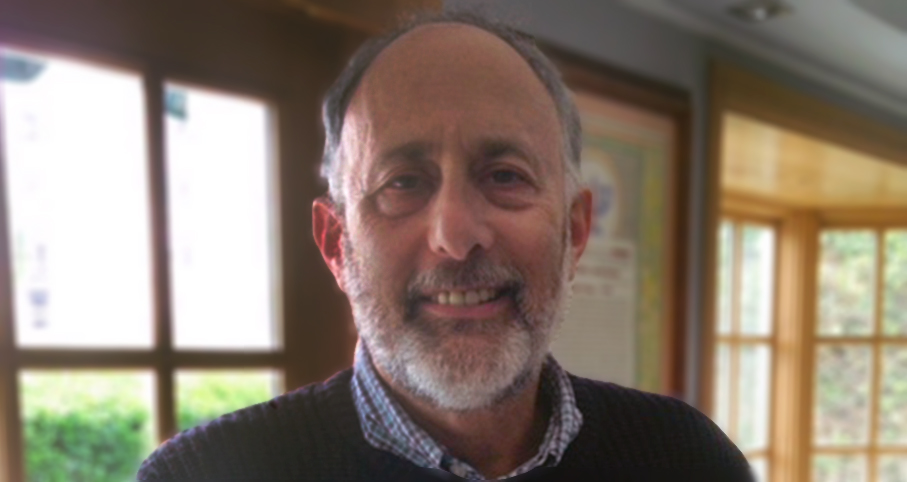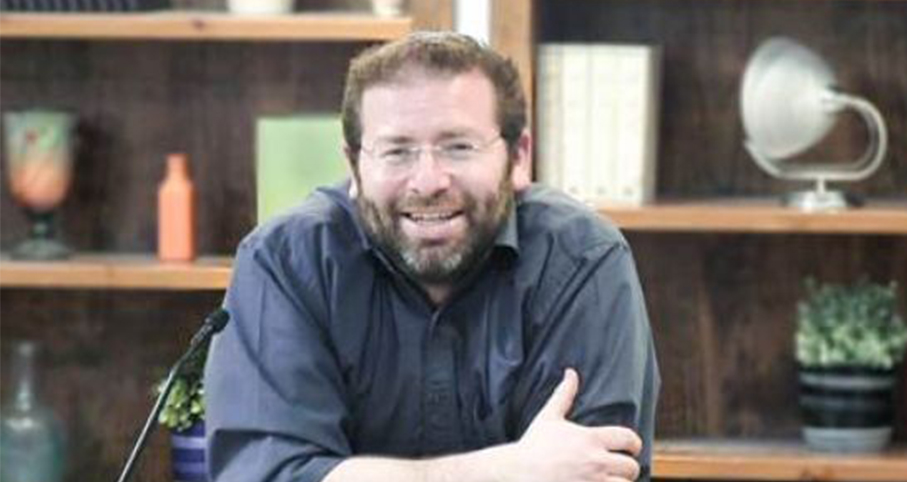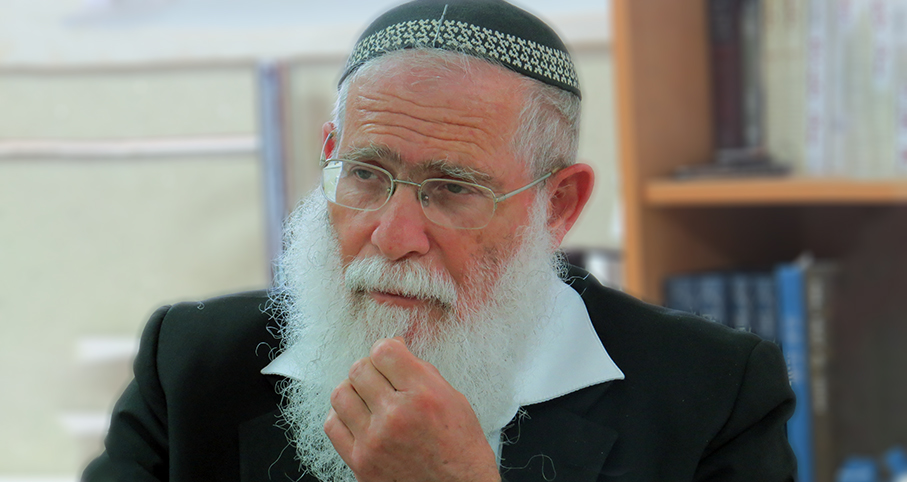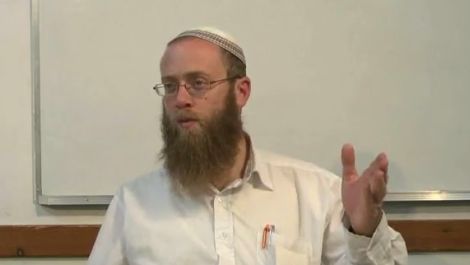Beit Midrash
- Torah Portion and Tanach
- Tanach
- Rut
- Shabbat and Holidays
- Shavuot
- Articles about Shavuot
An Ammonite or a Moavite should not enter the congregation of Hashem. Even the tenth generation should not enter the congregation of Hashem, forever. Because of the fact that they did not come forward with bread and water when you were on your way out of Mitzrayim and because of the fact that they hired Bilaam ben Be’or of Pesor, Aram Naharayim, to curse you (Devarim 23:4, 5).
Since there are no indications that the nation of Ammon participated in employing Bilaam, the Ramban (ad loc.) explains that each of the two reasons specified here applies to only one of the two nations involved: The Ammonites are excluded from marrying into Klal Yisroel because they did not provide food for the Jewish people, thus not demonstrating any hakaras hatov for the fact that Avraham Avinu had saved their ancestor Lot, and Moav is banned for hiring Bilaam.
The Mishnah (Yevamos 76b) rules Ammoni velo Ammonis, Moavi velo Moavis, that the prohibition of marrying into the Jewish people applies only to male Ammonites and Moavites and their male descendants. Thus, a male member of the Moavite people who converts to Judaism is still prohibited from marrying someone born Jewish. However, a female Moavite convert and all her descendants, and the female descendant of a male Moavite convert may freely marry within Klal Yisroel. It is for this reason that Boaz was permitted to marry Rus, who was a Moavite.
The Gemara explains that only Ammonite men are included in the ban, since only men would have been involved in going out to present food and drink to the Jews. The female Ammonites' lack of involvement in this mitzvah may have been because of their extreme modesty – they never left their houses to be near unfamiliar men. Similarly, since we can assume that Bilaam was hired by the Moavite men, only they are prohibited from marrying into the Jewish people, not the women (see also Yerushalmi).
The Story of Rus
In addition to the above-quoted Mishnah, several other early sources discuss whether the prohibition preventing Moavites and Ammonites from marrying Jews is restricted to males or extends also to females. The first time we find this matter discussed is in the days of Rus. Megillas Rus tells us that Ploni Almoni, an uncle of Rus’s late husband Machlon, was concerned about marrying Rus pen ashchis nachalasi, lest I destroy my descendants (Rus 4:6), which Rashi explains to be a concern that his descendants born from Rus would not be allowed to marry other Jews, because of their Moavite ancestress. Rashi there explains that Ploni Almoni erred regarding the halachic rule of Ammoni velo Ammonis.
Yet, the comment of Ploni Almoni is peculiar. If he felt that female Moavites are prohibited from marrying Jews, why was he only concerned that his descendants would be banned and not about whether he himself was permitted to marry Rus? On the other hand, if he was willing to marry Rus because he knew that the prohibition is restricted to male Moavites, why was he concerned about his children? We will return to this question shortly.
The Story of David
The issue of whether Moavite women may marry Jews surfaced again concerning the lineage of King David, who was descended from Rus. A fascinating passage of Gemara describes an early halachic debate among several known Biblical personages – whom we see from this Gemara were exemplary Torah scholars. Doeig HaEdomi, a member of King Shaul’s retinue, and Avner ben Ner, Shaul’s chief-of-military-staff, debate the halachic issue concerning whether Moavite women may marry Jews. The discussion between them is what one expects from Talmidei Chachamim of the first order, vociferously debating a halachic issue in your local Beis Medrash. But first let us examine the historical context.
Background to the Story
After Shaul failed to destroy Amalek and he had been told that he would therefore lose the monarchy, Hashem commanded Shmuel to clandestinely anoint David, the youngest of Yishai’s eight sons, as the new King of Israel. Shmuel carried out this mission, but it had been kept a complete secret.
At this time, Shaul began suffering bouts of depression. Shaul’s advisers sought out someone who could play music and thereby help Shaul cope with his depression. One of Shaul’s attendants knew David and suggested him for the position. David tried out for the position and was very successful. Shaul then sent a message to Yishai, David’s father, requesting that David be allowed to assume this position permanently. David did fill the position, and Shaul loved David tremendously, and had David also assume the role of being the royal armor-bearer. Shaul sent a second message to Yishai, requesting that David remain with Shaul "for he has found favor in my eyes" (Shmuel I 16:14-23).
At this point, the Pelishtim (Philistines) waged war against the Jews. The Pelishtim had a giant warrior among them, Golyas (known in English as "Goliath"), who stood over six amos tall (well over ten feet!). Golyas would taunt the Jews with his powerful, terrifying voice. Golyas challenged the Jews to send one representative who would face off in battle against him, with the nation of the victor taking the members of the other nation as slaves. At the same time, Golyas screamed blasphemous declarations about Hashem. The Jewish troops were terrified of Golyas (Shmuel I 17:1-11).
At the time, David’s three oldest brothers served in Shaul’s army. Yishai, David’s father, who is described as zakein ba va’anashim, meaning a well known personage, sent David to bring provisions to his brothers at the battlefront (Shmuel I 17:12). David discovered that Shaul was offering a vast reward to whoever would vanquish Golyas.
David the Brave
David, after gathering information about the situation, volunteered to fight Golyas by himself. Shaul discouraged David, noting that Golyas was an experienced warrior, whereas David was not.
David replied that Hashem is the One who provides all salvation, and that Hashem often helped David fight lions and bears while he was tending his sheep. Shaul gave David his blessing.
Shaul’s armor was placed upon David, but David said that he could not move freely with the armor, and removed it. David then took five smooth stones from a stream and placed them in his shepherd’s bag.
When Golyas saw David, he taunted him, saying "I will offer your flesh to the birds of the heavens and the animals of the field," to which David responded: "You come against me with sword, spear and javelin, and I come against you with the Name of Hashem, Master of Armies, the G-d of the troops of Israel." At this point, David took his slingshot, shot one stone that struck Golyas on the forehead, and Golyas fell dead. David then took Golyas’s sword, chopped off his head and demonstrated to all the Pelishtim that their hero was dead. The Pelishtim fled, and on that day, the Jews vanquished their enemy.
Now we come to the strangest part of the story:
"And when Shaul saw David move forward against the Pelishti, he said to Avner, his general, ‘Avner, whose son is this lad?’ And Avner answered, ‘As you live, O King, I do not know.’ And the king responded, ‘Find out whose son is this lad’" (Shmuel I, 17:55-56).
This last part of the story is bizarre. Both Shaul and Avner certainly knew David well -- David was Shaul’s armor-bearer and the one who played music to treat Shaul’s fits of depression. Furthermore, they were also familiar with Yishai, who was a well-known personage and with whom Shaul had negotiated twice for David’s employ.
The Gemara Passage
As we can imagine, we are not the first to ask these questions: They form the basis of a fascinating Talmudic discussion (Yevamos 76b-77a).
The Gemara asks why Shaul asked Avner who David and Yishai were; he knew them both, very well. The Gemara answers that he suspected that David might be the person who would be replacing him as king of the Jews. Shaul inquired whether David was descended from the branch of Yehudah that was destined to be the Jewish royal family. Thus, the question "Avner, whose son is this lad?" was not about David’s identity but about his genealogical roots.
At this point, Doeig HaEdomi piped up, "Rather than ask concerning whether he is appropriate to become king, you should ask whether he may marry into the Jewish people. After all, he is descended from Rus, the Moavite." To this, Avner retorted that we know that the halachah is that only male descendants of Ammon and Moav are prohibited, and therefore Rus was permitted to marry into the Jewish people. Doeig, however, disputed the veracity of this ruling. A halachic debate ensued between Doeig and Avner, concerning whether one can prove from the verses that the prohibition against Ammon and Moav is limited to males, or whether it extends also to the female descendants. Doeig won the upper hand in the debate, producing irrefutable arguments that females are also prohibited.
What was Doeig’s Argument?
As explained by the Ritva (ad loc.), Doeig insisted that the prohibition against marrying Ammonites applies equally to men and women of this nation. In his opinion, the Ammonite women equally share blame for the discourtesy they showed the Israelites, since the Ammonite women should also have provided food and water. He disputes with excusing their not providing help as attributable to their extreme modesty, since the Ammonite women should have assisted the Jewish women .
But what about the Moavite women?
But wait one minute! This concern should not affect David, who was descended from Moav, not from Ammon, and the Moavite women cannot be accused of hiring Bilaam. However, Doeig contended that Moavite women are also prohibited. Although it may be true that Bilaam was hired by the men, since the prohibitions against marrying Moavites and Ammonites are mentioned together, just as female Ammonites may not marry Jews, the same applies to female Moavites (Rashba, Yevamos 76b).
When Avner was unable to disprove Doeig’s approach, Shaul referred the issue to the scholars who debated such matters in the Beis Medrash. These scholars also responded that the prohibition banning the marriage of Ammon and Moav applies only to males and not to females. Doeig then proceeded to demonstrate that their approach was incorrect, leading the scholars of the Beis Medrash to conclude that their previous assumption was wrong and that henceforth the halachah would be that female descendants of Ammon and Moav are prohibited from marrying into Klal Yisroel. This ruling would seriously affect David and all his family members. Boaz had married Rus assuming that the prohibition banning Moavites applied only to males, and now the scholars of the Beis Medrash were considering banning Moavite and Ammonite women and all their descendants.
Amasa to the Rescue!
They were about to conclude that this is the halachah, when another scholar, Amasa, who was also a general in Shaul’s army, rose and declared, "I have received a direct mesorah from Shmuel’s Beis Din that the prohibition relates only to male descendants and not to female ones." This last argument apparently turned the entire debate back in favor of Avner’s original position, and it was accepted that David and all of Yishai’s descendants could marry within Klal Yisroel (Yevamos 76b-77a).
What did Amasa’s declaration change? In what way did this refute Doeig’s arguments?
Based on a halachic explanation of the Rambam (Hilchos Mamrim 1:2), the Brisker Rav explains what changed.
There are two basic types of Torah laws:
(1) Those that are handed down as a mesorah from Moshe Rabbeinu at Har Sinai.
(2) Those derived on the basis of the thirteen rules with which we derive new halachos, called in English the hermeneutic rules.
Let me explain each category by using examples:
Mesorah
We have a mesorah that the Torah’s requirement that we take "the fruit of a beautiful tree" on Sukkos refers to an esrog. No halachic authority in Klal Yisroel’s history ever questioned this fact, and for a very simple reason. We know this piece of information directly from the great leaders of Klal Yisroel who received this information from Moshe Rabbeinu, who heard it directly from Hashem (Rambam, Introduction to the Commentary on the Mishnah).
Logic
However, there are also Torah laws that were not taught with a direct mesorah from Har Sinai, but are derived through the hermeneutic rules of the Torah. For example, there is a dispute among tana’im whether a sukkah requires four walls to be kosher or whether it is sufficient if it has three. This debate is based on two different ways to explain the words of the Torah (Sukkah 6b).
Mesorah Versus Logic
Are there any halachic distinctions between the two categories of Torah-derived laws? Indeed, there are. The Rambam explains that when the position is based on logic, halachic authorities may disagree what is the halachah. Thus, there can be a dispute among tana’im whether a sukkah must have three walls or four. However, there can never be a dispute concerning a matter that Klal Yisroel received as a mesorah. Once a greatly respected Torah authority reports a mesorah from his rebbe, who in turn received this mesorah back to Moshe Rabbeinu, that a specific halachah or principle is true, no one can question this mesorah. Thus, any dispute about a halachah of the Torah can concern only something derived logically with hermeneutic principles.
There is another halachic difference between something taught by mesorah and something derived through logic. The final decider of all halachah in every generation (until the end of the era of the Talmud) was the Sanhedrin, also often called the Beis Din HaGadol, the supreme Beis Din. Once the great Torah scholars of Klal Yisroel participated in a debate in the Beis Din HaGadol, which then reached a decision, their conclusion is binding on all of Klal Yisroel (Rambam, Hilchos Mamrim 1:1; Comments of Ramban to Sefer HaMitzvos, Rule II).
There is a question whether a Beis Din HaGadol may overturn a ruling that had been decided previously, either its own decision or one made by an earlier Beis Din HaGadol. The answer to this question depends on whether the ruling involved was based on logic or whether it was taught by mesorah. When the original decision was reached by logic, then a later Beis Din HaGadol has the authority to reexamine the case, and, should it decide to, overturn the previous ruling.
However, this can never happen with a law whose source is mesorah. There can be no debate, no discussion and no overturning. Once a recognized scholar announces that he received this law as a mesorah from Sinai, this is accepted by all, and no debate or questioning of this mesorah may transpire.
Thus, it makes a tremendous difference in halachah whether something is a mesorah, which means it is not subject to argument or debate, or whether it is based on an interpretation of the hermeneutic rules, which is subject to argument and debate.
On the basis of these rules of the Rambam, the Brisker Rav (in his notes to the book of Rus in his Chiddushim on Tanach) explains why Amasa’s argument closed the debate in David’s favor. Doeig, Shaul, Avner, and the other members of Shaul’s Beis Medrash all assumed that limiting the prohibition of Ammoni and Moavi to males was based on hermeneutic exposition, and thus debatable. Furthermore, if Doeig demonstrated that his approach was logically correct, the long-established interpretation permitting Rus to marry into the Jewish people would be overturned. Indeed, the result of this ruling would be that Rus and all her descendants would be prohibited to marry into the Jewish people.
Amasa, however, explains the Brisker Rav, knew that the principle of Moavi velo Moavis, that female descendants of Moav could marry into Klal Yisroel, was a mesorah that Shmuel knew originated at Har Sinai. Thus, its basis was not a logical interpretation of the Torah, which can be refuted, but mesorah, which cannot. Therefore, a logical interpretation concluding otherwise was completely irrelevant.
At this point, we can return to an earlier question we asked about the story of Megillas Rus. Ploni Almoni, Machlon’s uncle, seems convinced that he may marry Rus, notwithstanding her Moavite origins, yet he was concerned that his descendants from her might not be allowed to marry other Jews. The Brisker Rav explains that Ploni Almoni assumed that the law permitting Moavite women to marry Jews was based on logic, which might at some time in the future be refuted, thus changing the accepted halachah. At that point, the ability of his descendants to marry Jews would be overturned. However, Ploni Almoni was incorrect, since the halachah that Moavite women may marry Jews is mesorah, and therefore irrefutable. There can and will never be a question as to whether the descendants of Boaz and David may marry Jews, notwithstanding their Moavite origins.
Conclusion
Besides the halachic issues regarding the pedigree of David, which are of supreme importance to us, since they are the basis of the lineage of Mashiach, we learn a very important lesson from the marital restrictions of the Moavites. One of the three identifying characteristics of the Jewish people is our quality that we are makir tov, we appreciate what others, and especially Hashem, have done for us and acknowledge that appreciation. From this mitzvah, we see how concerned we should be about developing the qualities that characterize the Jewish people.
-To engage further with Rabbi Sacks’s teachings, or to sign up to his mailing list, please go to www.rabbisacks.org





















